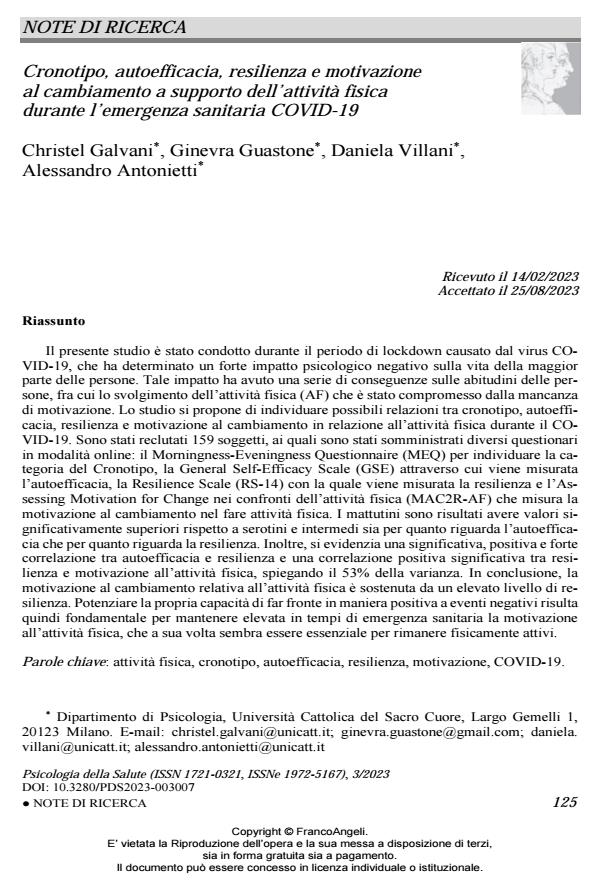Psychological dimensions supporting physical activity during the COVID-19 lockdown
Journal title PSICOLOGIA DELLA SALUTE
Author/s Christel Galvani, Ginevra Guastone, Daniela Villani, Alessandro Antonietti
Publishing Year 2023 Issue 2023/3
Language Italian Pages 12 P. 125-136 File size 208 KB
DOI 10.3280/PDS2023-003007
DOI is like a bar code for intellectual property: to have more infomation
click here
Below, you can see the article first page
If you want to buy this article in PDF format, you can do it, following the instructions to buy download credits

FrancoAngeli is member of Publishers International Linking Association, Inc (PILA), a not-for-profit association which run the CrossRef service enabling links to and from online scholarly content.
This study was conducted during the lockdown period caused by the COVID-19 virus, which resulted in a strong negative psychological impact on most people’s life. This impact had different consequences on people’s habits, including physical activity (PA), which was compromised by a lack of motivation. High levels of motivation for PA were found to be fun-damental for practicing the correct amount of exercise. The study aimed at identifying possible relationships between chronotype and self-efficacy, resilience and motivation for change in relation to physical activity during COVID-19. One hundred and fifty-nine adults were re-cruited. Four questionnaires were administered online: the Morningness-Eveningness Ques-tionnaire (MEQ) to identify the chronotype, the General Self-Efficacy Scale (GSE) to evaluate self-efficacy, the Resilience Scale (RS-14) to categorize resilience, and the Assessing Motiva-tion for Change towards Physical Activity (MAC2R-PA) to detect the motivation for change towards physical activity. Morning-type individuals were found to have significantly higher values than evening- and intermediate-types in terms of both self-efficacy and resilience. There was a significant, high, positive correlation between self-efficacy and resilience and a positive, significant relationship was found between motivation for change towards physical activity and high resilience scores, which explained the 53% of the variance. In conclusion, the moti-vation for change related to physical activity is supported by a high level of resilience. Strengthening one’s ability to cope positively with negative events is therefore essential to keep motivation for physical activity high in times of a health emergency, which in turn seems to be essential for staying physically active.
Keywords: physical activity, chronotype, self-efficacy, resilience, motivation, COVID-19
Christel Galvani, Ginevra Guastone, Daniela Villani, Alessandro Antonietti, Cronotipo, autoefficacia, resilienza e motivazione al cambiamento a supporto dell’attività fisica durante l’emergenza sanitaria COVID-19 in "PSICOLOGIA DELLA SALUTE" 3/2023, pp 125-136, DOI: 10.3280/PDS2023-003007